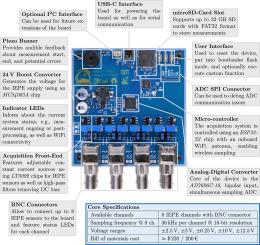OASIS-UROS: Open acquisition system for IEPE sensors - upgraded, refined, and overhauled software
IF 2.1
Q3 ENGINEERING, ELECTRICAL & ELECTRONIC
引用次数: 0
Abstract
OASIS-UROS continues the previously published Open Acquisition System for IEPE Sensors (OASIS). While still building on the ESP32 microcontroller, this version improves the overall performance by switching to an SD card caching system and upgrading the analog-digital converter to an AD7606C-18, which has a higher resolution, provides eight channels, oversampling, and software-adjustable voltage ranges. Also improved is the IEPE front-end and power supply, as well as the firmware of the acquisition system, which can now achieve a sample rate of up to 36 kHz while sampling all eight channels. This paper documents the hardware and software of OASIS-UROS and provides all materials required to reproduce the open acquisition system. Lastly, the system was validated against commercial hardware and software in an experimental modal analysis context. This showed that the system performs close to the commercial one in some aspects with respect to the utilized test case. While OASIS-UROS cannot match the full performance of the commercial system, the developed system can be a viable alternative for students, people in academia, or smaller companies that have a constrained budget or require complete insight as well as adaptability of the hardware and software.

OASIS-UROS:用于IEPE传感器的开放式采集系统——升级、改进和大修软件
OASIS- uros延续了先前发布的IEPE传感器开放采集系统(OASIS)。该版本仍然基于ESP32微控制器,通过切换到SD卡缓存系统并将模数转换器升级为AD7606C-18,提高了整体性能,AD7606C-18具有更高的分辨率,提供8通道,过采样和软件可调电压范围。IEPE前端和电源以及采集系统的固件也得到了改进,现在可以实现高达36 kHz的采样率,同时采样所有8个通道。本文记录了OASIS-UROS的硬件和软件,并提供了复制开放采集系统所需的所有材料。最后,在实验模态分析环境下,对系统进行了商用硬件和软件的验证。这表明该系统在使用的测试用例方面在某些方面的性能接近于商业系统。虽然OASIS-UROS不能与商业系统的全部性能相匹配,但开发的系统可以成为学生、学术界人士或预算有限或需要完全洞察力以及硬件和软件适应性的小型公司的可行替代方案。
本文章由计算机程序翻译,如有差异,请以英文原文为准。
求助全文
约1分钟内获得全文
求助全文
来源期刊

HardwareX
Engineering-Industrial and Manufacturing Engineering
CiteScore
4.10
自引率
18.20%
发文量
124
审稿时长
24 weeks
期刊介绍:
HardwareX is an open access journal established to promote free and open source designing, building and customizing of scientific infrastructure (hardware). HardwareX aims to recognize researchers for the time and effort in developing scientific infrastructure while providing end-users with sufficient information to replicate and validate the advances presented. HardwareX is open to input from all scientific, technological and medical disciplines. Scientific infrastructure will be interpreted in the broadest sense. Including hardware modifications to existing infrastructure, sensors and tools that perform measurements and other functions outside of the traditional lab setting (such as wearables, air/water quality sensors, and low cost alternatives to existing tools), and the creation of wholly new tools for either standard or novel laboratory tasks. Authors are encouraged to submit hardware developments that address all aspects of science, not only the final measurement, for example, enhancements in sample preparation and handling, user safety, and quality control. The use of distributed digital manufacturing strategies (e.g. 3-D printing) is encouraged. All designs must be submitted under an open hardware license.
 求助内容:
求助内容: 应助结果提醒方式:
应助结果提醒方式:


